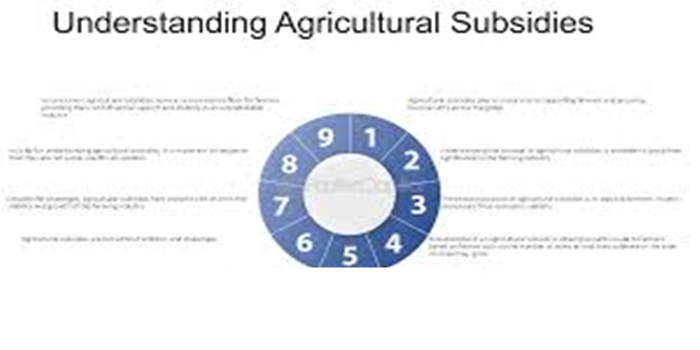In this article, we discussed agricultural subsides, the types, the objective, the benefits, we also talked about the challenges.
Definition
Agricultural subsidies are financial or in-kind supports provided by governments to farmers and agribusinesses to promote agricultural production, stabilize prices, and ensure food supply.
An agricultural subsidy (also called an agricultural incentive) is a government incentive paid to agribusinesses, agricultural organizations and farms to supplement their income, manage the supply of agricultural products, and influence the cost and supply of such commodities.
Types of Agricultural Subsidies
Direct Payments: These are direct transfers of money to farmers, often based on historical production data, land ownership, or farm size. These payments may or may not be tied to current production.
Input Subsidies: These subsidies aim to reduce the cost of essential farming inputs for farmers, such as fertilizers, seeds, pesticides, irrigation water, or fuel. The goal is to lower production costs and encourage the use of technologies that can increase yields.
Price Supports: These mechanisms maintain the market price of specific agricultural commodities at or above a certain level. This can be achieved through government purchases of surplus products or by setting minimum prices to ensure farmers receive a favorable return.
Subsidized Insurance: Governments often subsidize the premiums for crop insurance, which protects farmers against financial losses from natural disasters, disease outbreaks, or price declines. This reduces the financial risk for farmers and helps them continue production in uncertain conditions.
Conservation Payments: Some subsidies are provided to farmers for implementing practices that protect or improve the environment, such as conserving land, maintaining landscapes, or using sustainable farming methods.
The Objectives of Agricultural Subsidies
Income Support for Farmers: Subsidies help supplement farmers’ incomes, acting as a safety net against volatile market prices and unpredictable factors like adverse weather or natural disasters. This allows farmers to remain in business and maintain a stable livelihood.
Encouraging Specific Agricultural Practices: Governments use subsidies to promote certain farming practices that align with their policy goals. This can include encouraging the production of specific crops deemed essential for national security, or incentivizing sustainable and environmentally friendly methods to reduce resource depletion.
Stimulating Rural Economic Development: By supporting the agricultural sector, subsidies help to keep rural economies strong. They can encourage job creation in farming and related industries and support the overall economic activity in rural areas.
Improving Agricultural Productivity: Subsidies can lower the cost of essential farming inputs like fertilizers, seeds, and machinery, which in turn encourages farmers to adopt new technologies and improve their overall productivity and crop yields.
The Benefits of Agricultural Subsidies
or Farmers and Rural Communities
Income Stability: Subsidies provide a financial safety net for farmers, protecting them from market volatility caused by unpredictable factors like bad weather, pests, or fluctuations in global prices. This helps ensure a stable income and allows them to remain in business.
Encourages Production and Investment: By lowering the cost of inputs like seeds, fertilizers, and machinery, subsidies incentivize farmers to adopt new technologies and modern farming practices. This can lead to increased productivity and higher crop yields.
Rural Economic Development: By sustaining the agricultural sector, subsidies help maintain rural economies. This support can create jobs in farming and related industries and prevent rural depopulation.
For the Economy and Consumers
Ensures Food Security: Subsidies help maintain a stable, domestic food supply. This reduces a nation’s reliance on imported food and protects against potential disruptions in global trade or geopolitical instability.
Affordable Food: By keeping production costs low, subsidies can lead to lower prices for consumers. This makes food more accessible and affordable, which is particularly beneficial for low-income households.
Supports Specific Industries: Governments can use subsidies to promote the production of specific crops or goods that are deemed important for national interests, such as essential grains or renewable energy sources.
The Challenges of Agricultural Subsidies
Economic and Trade-Related Challenges
Market Distortion and Overproduction: Subsidies can artificially inflate the supply of certain crops, leading to overproduction. This surplus can depress global market prices, making it difficult for unsubsidized farmers in developing nations to compete and potentially forcing them out of the market.
Fiscal Cost: Subsidies can be a significant financial burden on government budgets. The money used for subsidies could potentially be allocated to other public services like education, healthcare, or infrastructure.
Inequality and Resource Misallocation: A large portion of subsidies often goes to large, wealthy corporate farms, while smaller farmers may receive little to no support. This can exacerbate income inequality in the agricultural sector and lead to resource misallocation, as production may be based on subsidies rather than genuine market demand.
Stifles Innovation: Critics argue that by providing a safety net, subsidies can reduce the incentive for farmers to innovate, improve efficiency, or diversify their crops, leading to a dependency on government support.
Environmental Challenges
Environmental Degradation: Subsidies can encourage environmentally harmful practices. For example, subsidies for water or fertilizer may lead to their overuse, contributing to groundwater depletion and nutrient runoff that pollutes rivers and lakes.
Monoculture and Biodiversity Loss: By favoring a limited number of commodity crops (like corn or soy), subsidies encourage large-scale monoculture farming. This practice can deplete soil nutrients and reduce habitat diversity, harming local ecosystems and biodiversity.
Deforestation: In some cases, subsidies can indirectly contribute to deforestation as farmers clear land to increase production to maximize their subsidy payments.
Conclusion
Agricultural subsidies are a form of government support for farmers and agribusinesses. They can be financial or non-monetary and are used to influence agricultural production, prices, and the food supply.
READ: Agritourism and Farm Stays


